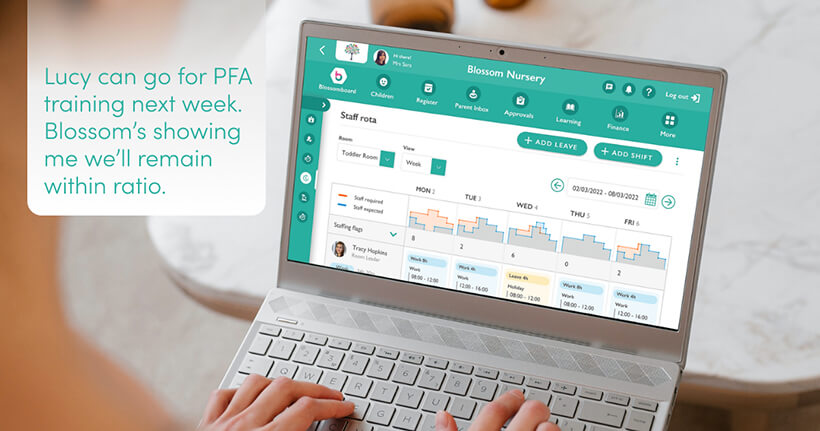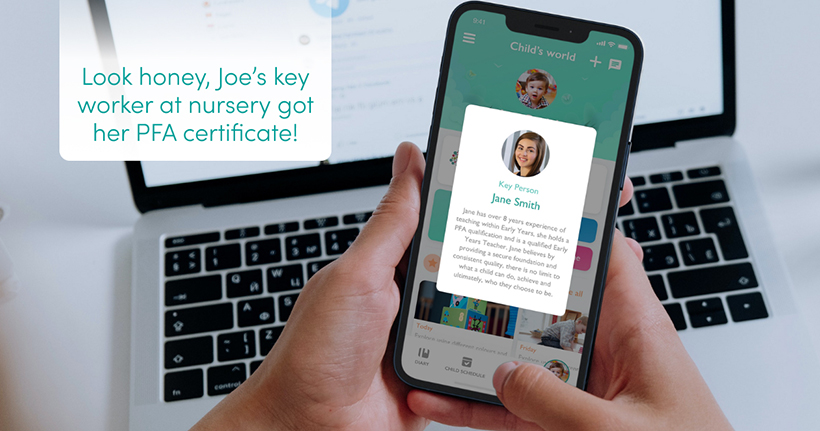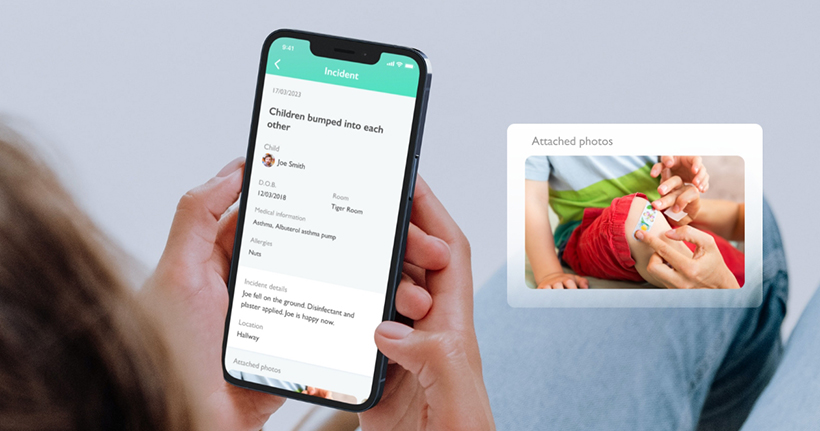Paediatric First Aid training is mandatory for your nursery staff, meeting statutory requirements for your Level 2 and Level 3 early years practitioners. Child-led learning offers rich developmental opportunities for babies and toddlers but is not without injury risks. In this article, we share who is legally required to be PFA-trained, why first aid training is beneficial for your nursery and how this boosts parental confidence in your nursery team.
Who must be Paediatric First Aid trained?
The statutory requirements for which nursery practitioners require first aid training are explained in the framework for the Early Years Foundation Stage (EYFS) with support from the non-statutory first aid guidance from the DfE. There must be at least 1 person who has attended and passed the full Paediatric First Aid (PFA) course readily available during nursery running hours, including on external outings.
If you have any nursery staff who are: employed as a Level 2 or 3 practitioner, used for child ratios, and who qualified post-June 2016, they must have a full or emergency PFA certification within 12 weeks of beginning employment. Childminders and any early years assistants who may be in sole charge for any period should have attended Paediatric First Aid training and have a current certificate.
Most nurseries have several staff members who have attended full and emergency PFA training courses. Covering for staff illness and absence, having multiple PFA-trained staff allows external visits and outings to go ahead safely. Ensure that you monitor staff ratios accurately when team members are on PFA training. Blossom’s staff rota planning provides total visibility of all your staff ensuring you stay within the statutory ratios needed.

What is covered in Paediatric First Aid training courses?
Full Paediatric First Aid training courses should last for a minimum of 12 hours and must include the content covered in the emergency PFA training course, with the additional elements found in Annex A in the statutory framework for EYFS. All PFA courses must be delivered by a suitably qualified and competent training provider. Content that must be covered includes being able to:
- Help a baby or child who is suffering from anaphylactic shock,
- Help a baby or child who has had an electric shock,
- Help a baby or child who has burns or scalds,
- Help a baby or child who has a suspected fracture,
- Help a baby or child with head, neck or back injuries,
- Help a baby or child who is suspected of being poisoned,
- Help a baby or child with a foreign body in eyes, ears or nose,
- Help a baby or child with an eye injury,
- Help a baby or child with a bite or sting,
- Help a baby or child who is suffering from the effects of extreme heat or cold,
- Help a baby or child having: a diabetic emergency; an asthma attack; an allergic reaction; meningitis; and/or febrile convulsions.
Emergency PFA courses can be completed in a face-to-face one-day course and must last a minimum of 6 hours. With the following areas covered:
- Be able to assess an emergency situation and prioritise what action to take,
- Help a baby or child who is unresponsive and breathing normally,
- Help a baby or child who is unresponsive and not breathing normally,
- Help a baby or child who is having a seizure,
- Help a baby or child who is choking,
- Help a baby or child who is bleeding,
- Help a baby or child who is suffering from shock caused by severe blood loss (hypovolemic shock).
How to book a Paediatric First Aid training course
You can book PFA courses (full and emergency) through a wide range of providers who offer regulated qualifications. Many voluntary aid societies (like St John Ambulance, British Red Cross and St Andrew’s First Aid) are recommended by the Health Safety Executive (HSE) as quality first aid training providers. There is further first aid guidance available from the HSE to help you choose a training provider.
How long do Paediatric First Aid qualifications last?
Paediatric First Aid training courses should be retaken or refreshed every 3 years. It is beneficial to refer regularly to your nursery setting’s first aid risk assessment and organise any additional Continuing Professional Development (CPD) for your staff to meet the needs of the children.
For example, multiple early years practitioners may complete their PFA at the same time, to save costs when booking the PFA course, and are not due to refresh their training for a further 3 years. One year after the PFA course is completed, a child joins the nursery with type 1 diabetes and requires insulin management. Your nursery should organise diabetes training for staff members to support the child’s needs effectively, demonstrating good inclusive practice at your nursery.
Parents will appreciate updates on when your team members attend PFA courses or additional medical CPD, increasing confidence in the proactivity and competence of your early years setting. You can notify parents of new staff qualifications with Blossom’s Parent App to celebrate how you invest in staff CPD for the health and well-being benefit of their child.

Should all of my nursery staff be PFA trained?
Some nurseries choose to invest in PFA training for all staff, reducing nursery staff timetabling issues when making sure a PFA-trained staff member is available at all times. Blossom’s staff profile helps track your nursery team’s qualifications, helping you to spot gaps in first aid training across your nursery site. And supports you with creating a bespoke CPD plan for your nursery, helping you to retain staff through investing in their progression.
Why should nursery staff be PFA trained?
There are plenty of benefits to having all of your nursery staff trained in first aid administration (either full or emergency PFA).
Parent peace of mind
Parents will feel more confident in your team’s ability to respond to injury or emergency with their child. When you share regular updates of staff medical CPD courses via your nursery software, positive word of mouth during parent-to-parent discussions can strengthen your nursery brand. This is just one of the ways using your nursery software can help boost parent-nursery relationships, and build confidence and communication.
Prepared for infant medical emergency
In an emergency, it is vital for all of your nursery staff to be calm and knowledgeable about the next steps. Investing in PFA CPD for all of your early years practitioners builds collective understanding and knowledge of what steps to take in a medical emergency.
Satisfying legal compliance in EYFS
When Ofsted visits, they will check your nursery’s legal compliance with CPD and medical reporting processes. Having all of your staff qualifications easily accessible online in staff profiles demonstrates your diligence in ensuring your staff have the correct, and current, qualifications required.
Invest in nursery staff CPD
It’s no secret that the early years sector has recruitment challenges, your role as a nursery manager or owner is to try to recruit and retain an incredible EYFS team. Investing in your practitioners’ CPD is one of the key ways to make staff feel valued and supported in your nursery. During regular appraisal meetings, discuss with your team their interests and goals to find suitable CPD opportunities for them, such as PFA training.
How to report injuries to parents in EYFS
Your nursery setting should keep a detailed record of any accidents, injuries and first aid administration undertaken. Parents should then be informed of any injuries their child has experienced during their time at the nursery and the treatment they have received.
Your practitioners can quickly record and share medical and first aid information with parents via Blossom’s Parent App. Managers and owners benefit from Blossom’s notification feature which sends an immediate notification to leadership teams when an incident occurs, allowing full visibility of medical treatment nursery-wide (even if you’re offsite).
Top tip:
Audit your nursery insurance policies to keep your business protected against injury claims and ensure your EYFS practitioners are covered by public liability insurance.

Does Paediatric First Aid count as CPD?
Anything that builds knowledge, motivates staff, helps to develop teaching strategies and embeds good practice counts as CPD in EYFS. PFA training is an important CPD course that boosts staff knowledge to support children, colleagues and visitors with first aid needs. Some other examples of CPD in the early years include:
- Virtual CPD courses
- Face-to-face workshops
- EYFS practitioner team meeting
- Observing other team members’ practice
- Professional conversations
- Extended CPD reading
What should my nursery first aid kit contain?
The HSE shares first aid kit guidance for EYFS settings and schools. This is guidance only and it is encouraged that nurseries will refer to their first aid risk assessment tailored to their setting for specific items.
The entire nursery team must be aware of the location of the first aid kit- you may choose to have several across the setting! Remind your nursery staff that they can see any allergies and medical requirements on the child’s online profile to prevent emergency situations from arising.
Your nursery first aid kit may contain:
- A minimum of 20 sterile adhesive dressings,
- 2 sterile eye pads,
- 2 triangular bandages,
- Several safety pins (recommended 6),
- 6 average-sized unmedicated wound dressings,
- 2 large-sized unmedicated dressings for wounds,
- Several pairs of disposable gloves
Subscribe to receive expert advice and tips from seasoned professionals in the early years sector.